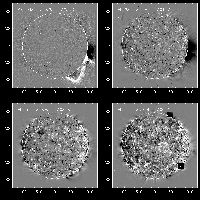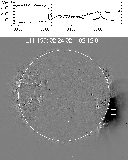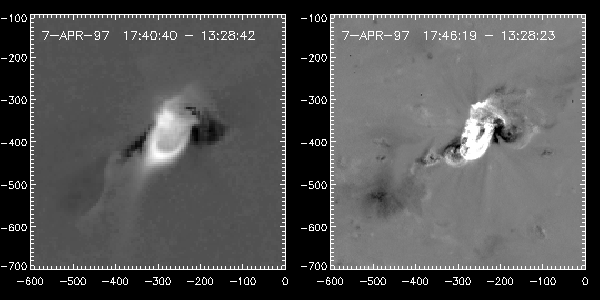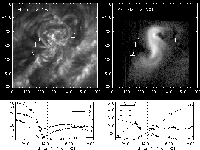Weekly Notes from the Yohkoh Soft X-Ray Telescope
(Week 21, 2002)
Science Nugget: May 24, 2002
Comparing coronal dimming at
different temperatures
Introduction
Many of us believe that "coronal dimming" is an important observational
signature for understanding the origin of coronal mass ejections (CMEs).
In fact, dimming has been taken up several times in these science nuggets
(for example, see
1,
2,
3). However, we still do not know how the dimming maps to the CME as
observed by a white-light coronagraph. A more basic question is "does
the dimming really represent mass depletion?" One may argue that
change in temperature can also lead to a decrease of signals. Therefore,
it is important to make multi-wavelength observations of the dimming
phenomenon. Such studies (e.g.,
paper by Zarro et al.)
have been not very common. Here, we compare SXT and EIT data for some
dimming events most likely associated with CMEs. Note that EIT is more
susceptible than SXT to temperature effect, but it appears that most of
the EIT dimming represents mass depletion due to CMEs.
Contrasting examples
The first event we take up here occured during solar minimum.
In
a previous nugget, an SXT difference image
(including super-long exposures) was given to show dimming around the time
of a CME. Here we replicate the figure made by PI of the SXT project
(click the following thumbnail to enlarge.)

Note that the dimming region is much smaller than the angular
extension of the CME.
A movie of SXT images
together with
a plot of the SXT light curve
indicates that dimming preceded what appears to be a filament eruption.
Interestingly, the following figure shows that EIT failed to reproduce
the dimming region except in the 284 Å channel. This implies that
only high-temperature (> 2 MK) plasma was involved in the process.

We should say this pattern (dimming observed by SXT but not in the EIT
195 Å channel) is quite uncommon. The following example was reported in
a previous nugget. Here the CME was most likely associated with a
major flare which would have been X-class. The CME roughly encompassed
an EIT dimming region as shown in
this figure. The following figure
shows the light curve of EIT dimming, which started 15 minutes before the
CME was first detected by LASCO (as indicated in the vertical dotted line).
The boxed area continued to be dimmed for hours only gradually recovering
around 04 UT.

In the previous nugget, we reported that the EIT dimming region roughly
matched a bright region in SXT.
Further analysis
reveals that at no instant was dimming seen in SXT data.
Disk events
Now we look at dimmings away from the limb. They are often referred to as
transient coronal holes and sometimes appear as double.
We first recall that in
the 1997 April 7 event, the dimming regions were similar in SXT and
EIT 195 Å data (see
the Zarro paper, and also the
following figure of SXT and EIT data).

But such a good match seems to be not always the case. For example,
a similar event was observed by EIT on 2001 November 21, which also
served as an example of global eruption from a S-shaped region
(see
a previous nugget). The following figure shows that only EIT data
nicely caught dimming around the time of the CME (the dotted vertical line).
This is because the SXT dimming tends to be of smaller amplitude and in
this case the flare emission affected the regions of EIT dimming.

Trans-equatorial events
Some CMEs originate from the eruption of large-scale loops including
those that cross the equator. These are characteristically flare
associated and the flare is located near one end of the large-scale
loops (see
the paper by Khan and Hudson,
but sorry no abstract at ADS). Interestingly, the disappearance of the
trans-equatorial loops was seen only in SXT difference images. In EIT,
different areas dimmed, and the SXT dimming region appeared bright.
See the following figure.

This pattern indicates that the SXT dimming may have been
due to cooling of the loops, which then appeared in EIT, but we need
more quantitative analysis. In addition, we have to mention that we could
not find a better example than this one (1998 May 6, as well as
May 8 and May 9) of the
disappearance of trans-equatorial loops in association with CMEs, when
we analyzed data for all the X-class flares in this cycle. This will
be presented in a later nugget.
Conclusions
Consistent with one's intuition, the dimming signatures in SXT data can be
subtle, and are not always easy to get. Sometimes flare emission occupies
the same line of sight as the pixels that may have experienced dimming.
At other times, the plasma contributing to a CME has temperature lower
than SXT can see (but remember the 1996 October 5 event shown above as a
counter example). There should be a contribution of increasing or
decreasing temperature to the EIT dimming, but the good correlation with
CMEs indicated that mass depletion is a dominant factor. The appearance
of dimming in SXT data due to CMEs may depend on the intensity and
location (including how far behind the limb) of the associated flare, and
possibly the type of ejection if there is a variety. The plasma
parameters of the CME with respect to the other part of the corona may
have some solar cycle dependence.
[Topical
index] -o- [Chronological
index]
May 24, 2002
N. Nitta (NVN) (nitta@lmsal.com)


